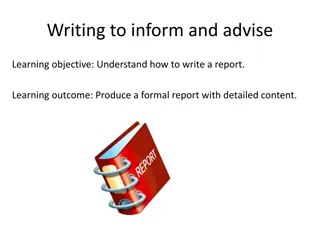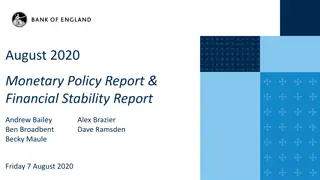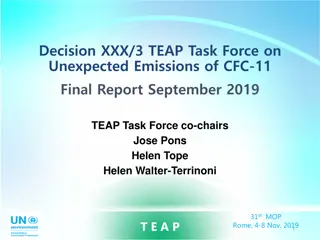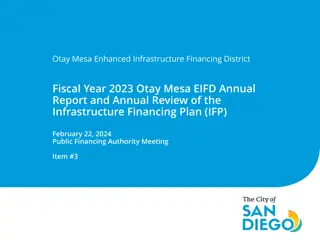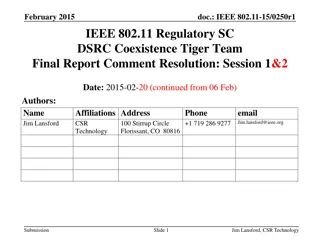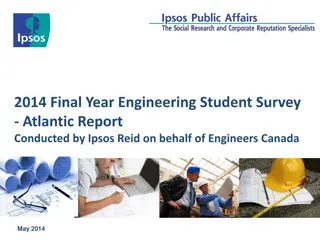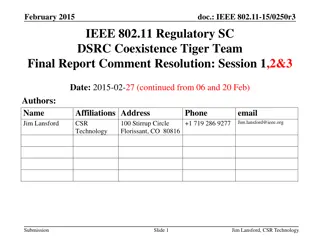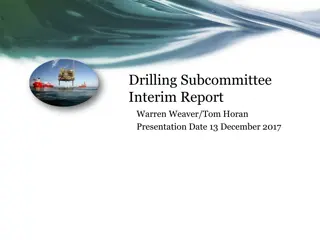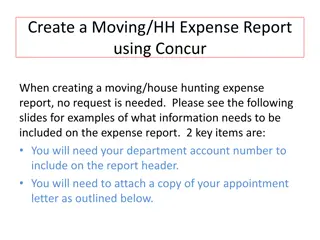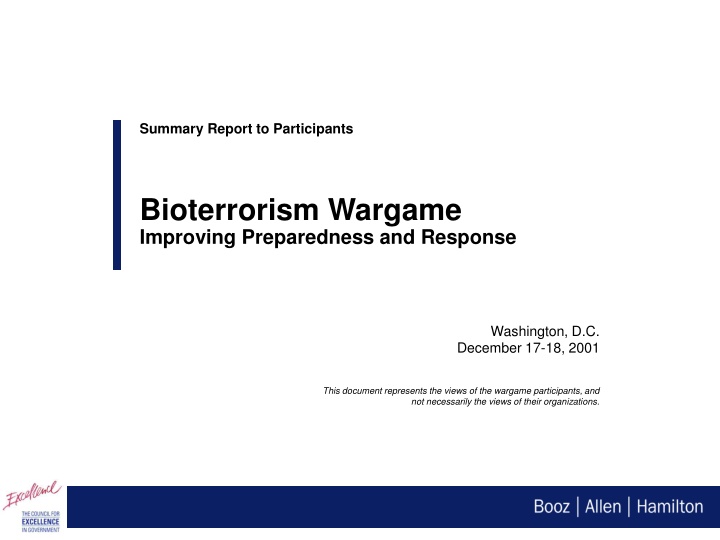
Improving Bioterrorism Preparedness and Response Insights
Explore innovative ideas and practical solutions for bioterrorism preparedness and response in this insightful report from the Bioterrorism Wargame conducted in Washington, D.C. Participants addressed pressing questions and identified next steps to enhance coordination, cooperation, and capabilities.
Download Presentation

Please find below an Image/Link to download the presentation.
The content on the website is provided AS IS for your information and personal use only. It may not be sold, licensed, or shared on other websites without obtaining consent from the author. If you encounter any issues during the download, it is possible that the publisher has removed the file from their server.
You are allowed to download the files provided on this website for personal or commercial use, subject to the condition that they are used lawfully. All files are the property of their respective owners.
The content on the website is provided AS IS for your information and personal use only. It may not be sold, licensed, or shared on other websites without obtaining consent from the author.
E N D
Presentation Transcript
Summary Report to Participants Bioterrorism Wargame Improving Preparedness and Response Washington, D.C. December 17-18, 2001 This document represents the views of the wargame participants, and not necessarily the views of their organizations.
This wargame was sponsored by the Council for Excellence in Government and Booz Allen Hamilton as a public service, in memory of lost colleagues and other victims of the September 11th attack. This scenario was used to assure America's readiness, but with the hope that a bioterrorism attack will never occur. 1
Table of Contents Executive Summary Key Learnings Team Recommendations for Action Team-Specific Observations Potential Impact of Scenario 2
Government and healthcare businesses explored innovative ideas and practical solutions to bioterrorism in a wargame The wargame conducted on December 17-18, 2001, in Washington, DC was designed to proactively mobilize government and healthcare businesses to explore innovative ideas and practical solutions to improve our nation s preparedness and response to bioterrorism Participants sought to answer pressing questions for the nation and for their individual organizations How should we better prepare for or respond in the event of a future bioterrorist attack? How can I bring the unique capabilities of my organization and my sector to bear on the challenges of a bioterrorism attack? What is in the minds of other players involved in the response? How does government think about this issue/ how do businesses think about this issue? What do other players have to offer that will help me respond? What are the implications of the actions of others on my ability to respond and on the overall goals of my organization? What are alternative industry and government partnership models to enhance our preparedness and response? Participants dealt with choices, dilemmas and consequences of their actions, and identified next steps to improve real world coordination, cooperation and capabilities 4
Government and healthcare business leaders came together to respond as a group to a simulated bioterrorist attack Government participants included senior policymakers in: Department of Health and Human Services Federal Emergency Management Agency Department of Defense Department of Veterans Affairs State and Local government Business participants included CEOs and senior executives in: Medical products companies, including pharmaceutical and biotechnology Healthcare providers including hospitals, HMOs and physicians Health insurers Health and industry associations 5
In the wargame, participants faced a bioterrorism attack resulting in a plague epidemic The scenario began with an attack using a weaponized infectious disease - pneumonic plague Unidentified persons launched aerosolized attacks in two cities simultaneously The epidemic started with several hundred infected patients Plague was known to be highly contagious No vaccine was available, but preventative antibiotics were known to be effective Plague was considered nearly 100% fatal without treatment within the first 18-24 hours of the initial appearance of symptoms and early symptoms are easily confused with influenza 6
The simulated epidemic began in Detroit/Windsor and Norfolk, and subsequently spread to 25 states in three weeks Three Days After Attack Three Weeks After Attack 11 in Windsor 2 304 in Detroit 4 126 in Norfolk 447 Sick 6,500 Sick States with Confirmed Cases States with Suspected Cases 108 Dead 220,000 Dead 7
Participants were organized into teams representing key business and government sectors A mix of government and business participants were assigned to each team What do we need? How can we help? How can we partner? HHS/FEMA GOVERNMENT STAKEHOLDER TEAMS DOD/VA HEALTH INSURERS STATE/LOCAL Dynamic interactive dialog BUSINESS STAKEHOLDER TEAMS MEDICAL PRODUCTS MEDICAL PROVIDERS CONTROL What are the consequences? Stakeholder Teams: Identified objectives Took actions Made recommendations Control Team: Structured game Introduced external shocks Monitored and arbitrated 8
Teams took actions to respond to the epidemic in a series of moves, providing insights they might apply in the real world Move One: Response Move Two: Sustainment Move Three: Insights How have your priorities changed? What additional steps must you take? What did you do in Move Two that you wish you had done earlier in the game? What are your objectives? What are the immediate steps that you must take? How prepared are you? What lessons learned from recent healthcare challenges (e.g., anthrax) can be applied here? What breaks? When? What do you need from others in order to maintain operations? What did you need in the game that you wish you had planned and prepared for before the scenario began? What might prevent you from implementing these steps? Do you have the capabilities, capacity? If not, how will you get them? How do government and business coordinate their responses? What is the model? What are the three things your team can do to maximize your contribution to the bioterrorism response? What are the risks to taking these steps? What are the economic consequences? What are your liability concerns? What are the risks to taking these additional steps? What are the longer term economic consequences? When might you need assistance? What are the key steps to take in the next six months so that industry and government can work better together? If government, what do you need from healthcare businesses? If healthcare business, what do you need from the government? What are the three things your team needs from others to implement the above? What is your message to the public? How will you communicate it? Attack Plus 3 Days Attack Plus 3 Weeks Looking Back 9
Teams concluded that massive immediate action, coordinated across government and business, was critical to success We thought we should save for a rainy day, but now we realize that this is the rainy day. DoD/VA Team Wargame Participant Government and business teams initially followed a conservative, measured approach Worried about over-treatment and side effects Struggled to define roles and understand who to go to for information, direction and resources Teams discovered that massive, immediate action was required Mass prophylaxis and protective isolation were required within the first few days of the epidemic to prevent spread throughout the cities and beyond, but these actions were not taken until move 2 (i.e., 3 weeks after the attacks) No mechanisms were in place to enable quick coordination across agencies and businesses to mobilize the resources available Teams concluded that the government alone cannot protect the American people from bioterrorism It is essential to mobilize business resources Coordination and cooperation across businesses is required to address the scale of the problem Rapid federal decision-making/resource push are required for expeditious state/local response Protective relief from various statutes (i.e., Sherman Anti-Trust) potentially would be required to enable desired levels of coordination and information sharing 10
Teams faced several dilemmas in responding to the bioterrorism attack Paradox number one To react quickly, industry needs a single point of contact with government But statutes, policies and programs for dealing with terrorism create multiple points of entry at the interagency and intergovernmental levels Paradox number two Aggressive containment and prophylaxis can limit the spread of the disease But moving too quickly might consume reserve capacity which may be needed for future contingencies Paradox number three Response plans normally focus efforts at the local level But bioterrorism quickly becomes a national problem, requiring coordination across local/state/federal government and healthcare businesses Paradox number four Suspending legal, regulatory, and procedural constraints may be necessary to meet immediate needs But such steps can create serious downstream consequences for public health and business viability 12
Teams observed that a lack of appropriate in-place mechanisms made it difficult to respond to the attack Prior planning enables rapid response, which is critical in containing an outbreak Immediate protective isolation and mass prophylaxis are critical to containment of contagious disease Mechanisms are needed to collect and share information on pharmaceutical and equipment stockpiles before and during crises Individual companies can scale up rapidly, but addressing a crisis like this requires coordinated efforts across companies and sectors No widely accepted mechanisms exist for setting priorities for emergency distribution of medicines, or deciding who gets prophylaxis first Defining essential personnel is extremely difficult There is little public awareness/education of disease control/prevention measures Many barriers to communication exist e.g., no shared language, different frames of reference, don t know who to call Distributing medicine and supplies over the last mile can be difficult in face of protective isolation, public fear, and security concerns 13
Teams suggested three major priorities for their new national security roles Enhanced Partnership Create policies, protocols and mechanisms for government/business partnership Expanded Knowledge Build and share the knowledge needed to drive decision-making Develop capabilities to counter bioterrorism New Capabilities 15
To enable massive immediate action, it it essential that we build and share the knowledge needed to make decisions If we knew how many people might die, we would have been out there handing out the drugs ourselves Wargame Participant Assess potential actions and their impact Develop epidemiological models of the top agents, looking at the impact of actions such as quarantine and prophylaxis Create economic impact models to understand the key stress points Identify and share international best practices Measure public health readiness Develop a national inventory of medical supplies, finished goods, and raw material, including volumes, lead times for distribution, surge capacity and surge lead time Establish metrics for and determine readiness of response mechanisms, including all applicable private, local, state and Federal response entities Develop emergency distribution models Share information across government and industry Communicate top 10 list of agents and train healthcare professionals to identify and treat Compile and publish a menu of government services, resources, and Interpret and communicate existing plans and legal structures for dealing with bioterrorism, including the Federal Response Plan and the Stafford Act update as needed for feedback 16
Policies, protocols and mechanisms are needed to coordinate government and business response It is better to innovate around a plan, than to invent a plan on the fly Wargame Participant Integrate response policies across federal, state and local government and health care businesses Clarify roles and responsibilities and rules of engagement Identify the key points of contact and authority Set frameworks and triggers for actions Address economic issues to ensure stability (e.g., triggers for bridge loans, grants, and indemnification) Develop policies jointly to ensure smooth coordination and cooperation from the outset - "On the first morning we were all protecting our information and protecting our turf, but by the afternoon we were no longer doing this Establish and communicate medical protocols for bioterrorism response Communicate preferred protocols for treatment and prophylaxis Create options for modified protocols in the case of shortages of materials or personnel Establish triage criteria Improve understanding of protective isolation, quarantine, and other measures to control the spread of disease Identify mechanisms for communication, rapid decision-making, coordination of responses, distribution, assessment and feedback Draw government and businesses together regularly to plan and improve crisis management Establish integrated, public/private cooperative bodies, such as the NSTAC/NCS/NCC system for emergency telecommunications Develop integrated databases for disease tracking and stockpile/resource monitoring Establish emergency communications system Create an emergency medical products distribution system Through public education, prepare citizens for their role in the response (e.g., like for Civil Defense System) Design a mechanism for coordinating capacity and resources across businesses 17
New capabilities are needed within these government and business organizations in order to execute their new roles We have become a vital part of national security Wargame Participant Create individual organization response plans that link to the overall national plan Educate public and private sectors on state/local plans and roles Borrow from international best practices and models Examine a model like the National Communications System (NCS) to draw government and the private sector together on a regular basis to plan for and improve crisis management Enhance HHS capability to perform its new national security missions Establish a crisis action communication system that provides directions and links key players (in business and federal, state, and local government) to rapidly mobilize resources and cope with immediate requirements Develop and disseminate a public health threat and response program (reinvent Civil Defense System) Strengthen the public health infrastructure at all levels to enable it to execute against homeland security policy Develop more effective/expeditious diagnostics and education of emergency departments, physicians, and other health care providers Enhance local detection and diagnostic capabilities, and link to a national system Provide preparation toolkits to local governments and individual hospitals Build rapid distribution models for medical products Expand flexible surge capacity at medical products companies Run simulations and drills at all levels to test new mechanisms and policies Pre-document rules of engagement for these catastrophic types of scenarios Create a federal template and fund planning and training for states to conduct integrated planning/training efforts 18
Teams concluded there is a real need for Private-Public Partnerships to improve bioterrorism preparation/response PRIORITY TASKS FOR HEALTHCARE PRIVATE-PUBLIC PARTNERSHIP Identify and involve relevant participants Establish agreed roles, responsibilities and decisions rights Provide guidance for and coordinate government/Industry contingency and communication plans Share information on stockpiles and surge capacities Establish alert and coordination mechanisms Pre-define economic, legal, and liability parameters and limits Coordinate public awareness and education efforts Identify sponsor to take leadership within Government Build trust through effective, value-added collaboration Mount public affairs campaign to explain goals the the public and other stakeholders 19
Team-Specific Observations A mix of government and business participants were assigned to each team to facilitate knowledge sharing and encourage a richer dialog on the issues and solutions. The observations of each team are often what the team members learned about each other s organization and are not necessarily gaps or deficiencies. 20
The State and Local Government Team observed a need for the government and private sectors to work together to develop and improve responses to bioterrorism Key Observations Internal Priorities Requests to Other Entities A leadership void in the beginning led to delays in action, with catastrophic results Create clear response plans before a crisis occurs Include business and government in planning Include plan for maintenance of essential services Include COG and COOP Communicate, train and drill CDC provide epidemiological data on a push basis Quarantine was critical to containing the disease HHS and/or medical supplies industry provide stockpile information Essential services must be sustained through local or state intervention in the event of a quarantine or other work and travel disruptions Establish mechanisms for timely interactions and communication Requests From Other Entities Logistics were a significant breaking point in the response Identify the scope and preparedness of resources available Assess National Guard resources Identify potential volunteer resources and mechanism to activate them Work with federal agencies to establish a single or coordinated point of contact and provide timely decisions Real-time epidemiological data would have significantly helped in decision-making Educate the public on their role in the crisis and on the benefits of protective isolation Identify international best practices for state and local responses Public fear led to non- compliance with quarantines 21
The HHS/FEMA Team observed that an Awareness-Education-Action Program is needed for the government, industry, and the public Key Observations Internal Priorities Requests to Other Entities A leadership void in the beginning led to delays in action, with catastrophic results Set expectations prior to event - make clear what HHS can and cannot provide Improve diagnostic capabilities at providers Medical supplies industry provide stockpile information Identify the roles and missions of all agencies and businesses and ensure these roles are clear to all involved Logistics were a significant breaking point in the response Requests From Other Entities Identify requirements, capabilities and gaps in required drugs and equipment (both medical and communication) needed for successful response to potential attacks Develop a detailed response plan Include economic concerns in response plans Establish a coordinated point of contact and provide timely decisions Real-time epidemiological data would have significantly helped in decision- making Develop capabilities for CDC to provide timely epidemiological data and protocols on a push basis Establish a coordination model, along the lines of the National Communications System Establish a strategic communications plan and mechanisms for cooperation and information exchange across government and business prior to and during an event Public fear interfered with effective response CDC provide epidemiological data, information, protocols and triage criteria HHS team was looked to as the source for all information and decisions Educate the public Communicate to the public Determine how much preparation is enough Establish surveillance and detection HHS build more operational capabilities/orientation Addressing economic issues is key to maintaining stability Help local and state governments plan Establish incentives for cooperation Provide a toolkit for state and local planning 22
Department of Defense/Veterans Administration Team observed a need to be more proactive in making their (i.e., DoD/VA) capabilities known to HHS, FEMA Key Observations Internal Priorities Requests to Other Entities A leadership void in the beginning led to delays in action, with catastrophic results Identify the roles and missions of all agencies and businesses prior to an event Whoever is in charge needs to step up Educate the public on their role in the crisis and on the benefits of protective isolation Establish a coordination model, along the lines of the National Communications System Logistics were a significant breaking point in the response Make others aware of DoD and VA resources, and of the procedures required to request them Build more operational capabilities and orientation at HHS Quarantine was critical to containing the disease Office of Homeland Security establish a planning/ coordination council involving relevant government and business entities Establish two-way communications and coordination mechanisms for: Epidemiological information Logistics of distribution DoD and VA resources were not pulled by other entities until offered Federal provide a toolkit for state and local to perform community based planning with business and community groups (San Antonio model) Establish surveillance and detection Surveillance and detection might have prevented the attack from resulting in a widespread epidemic Requests From Other Entities Provide information regarding available medications and emergency supplies Contribute logistic capabilities 23
The Medical Providers Team observed a need for a public-private task force to integrate disaster responses Key Observations Internal Industry Priorities Requests to Other Entities A government leadership void in the beginning led to delays in action, with catastrophic results Understand top potential agents and the epidemiological implications of potential attacks Government provide timely decision-making CDC assist in development and dissemination of understanding of top agents and implications Real-time epidemiological data would have significantly helped in decision-making CDC assist in establishing triage criteria Work with suppliers to establish an emergency delivery system Medical products suppliers assist in establishing an emergency delivery system Capacity and procedures were significantly strained HHS establish a communication and information dissemination system Identify providers role in prophylaxis distribution Cash flow was strained, and net losses might be significant, leading to potential instability Include economic considerations in government response plans Establish triage criteria Requests From Other Entities Build diagnostic capabilities 24
The Medical Suppliers (AKA Pharmaceutical) Team observed a need to establish an industry coalition to advise government and mobilize industry to better respond Key Observations Internal Industry Priorities Requests to Other Entities A government leadership void in the beginning led to delays in action, with catastrophic results Identify industry capabilities for top potential agents Quantity Ownership Lead times Raw material Alternative products (e.g., off- label, IND, expired) Deployment strategy Prepare a detailed response/contingency plan to guide crisis response, composed of: Medical Product availability and deployment plan iteratively developed, rehearsed and practiced. Regulatory, legal, liability, and other exceptions/exemptions in place Economic parameters pre-defined Escalation process and actions Logistics were a significant breaking point in the response Lack of information on available supplies and surge capacities also hampered the response Clearly delineate the roles responsibilities of state/federal leaders Designate POC in charge at Federal Level Identify responsible parties at State Level Identify first responders for 122 cities in the FRP Agree on authorities to alert industry and act Create alternative delivery and intake methods (e.g., dissolve in liquid and use bottling and beverage distribution system) Concern about profit/payment issues did not prevent action, but such issues might have a significant medium term economic impact Work with government to prepare a response plan Clarify the liability and indemnification issues associated with treatment/prophylaxis Requests From Other Entities Provide detailed industry capabilities Concerns about liability issues were a roadblock 25
The Insurers Team observed a need to assess stress thresholds and establish mechanisms that might be activated during a crisis to assure providers liquidity Key Observations Internal Industry Priorities Requests to Other Entities A government leadership void in the beginning led to delays in action, with catastrophic results Establish a system to provide uniform/coordinated communication with members, providers, employers, consultants/brokers in a crisis Create stronger focal points within the local, state, and federal government for information and decision-making To ensure stability and ability to cover commitments in existing plans, establish a government-based mechanism for liquidity Review existing liquidity mechanisms for providers to ensure they are adequately funded during such a crisis Insurers primary role is to facilitate consistent communication and ensure the delivery system is viable Strengthen and update Federal Response Plan Facilitate support for the Office of Homeland Security Broaden reach across industry and government Pursue appropriate emergency waivers and relief (e.g., privacy, fee schedules, prompt pay, health and safety rules) Enhanced federal investment in IT and connectivity infrastructure between and among providers and insurers Reassurance of coverage under existing benefits plans is critical Leverage study underway by the American Academy of Actuaries on bioterrorism financial exposure to understand economic implications for insurers Communication among entities and with the public broke down Economic issues did not prevent service to members, but long- term crisis (60-90 days) might produce serious industry challenge Requests From Other Entities 26
In the wargame, team actions significantly constrained the disease progression IMPACT OF TEAM ACTIONS DETROIT Quarantine actions lowered the transmission rate Quickly introduced containment approach/quarantine lowered the infection rate by 75% by Day 7 Prophylaxis drugs were mobilized from multiple sources Push packs provided prophylaxis for an additional 360,000 individuals beginning on Day 2 Additional prophylaxis was mobilized from government and industry stockpiles by Day 4 The medical products industry indicated they could provide an additional surge in 30 days to replenish depleted stockpiles National Guard assistance in prophylaxis distribution allowed for an increase in distribution capability from about 1,900 courses/day of treatment to 340,000 courses/day Hospital equipment capacity was increased, increasing ability to provide therapeutic care Additional ventilators were mobilized from the National Pharmaceutical Stockpile on Day 3 and from DoD on day 4 Non-critical patients occupying Intensive Care Unit (ICU) and Intermediate Care (IMC) beds were shifted to a lower level care facility ICU and IMC RNs began supervising other RNs, significantly increasing the specialized RN capacity 28
If only 50% of the Detroit population received prophylaxis, up to 1.8 million people might die in Detroit PROJECTED DISEASE PROGRESSION DETROIT Note: Quantitative outcomes estimated only for Detroit 100% 80% % of Population Treated with Prophylaxis 60% % Population 40% % of Population Dead (Total Dead 1.8MM) 20% Based on wargame assumptions 0% 0 8 16 24 32 40 48 56 64 72 80 88 96 104 112 120 128 136 144 152 Day 29
But, if 100% were immediately treated with prophylaxis, the mortality number in Detroit might drop to about 16,000 PROJECTED DISEASE PROGRESSION DETROIT % of Population Treated with Prophylaxis 100% 80% 60% % Population 40% Based on wargame assumptions % of Population Dead (Total Dead 16,000) 20% 0% 0 8 16 24 32 40 48 56 64 72 80 88 96 104 112 120 128 136 144 152 Day 30
With 90% of the population treated with prophylaxis the most realistic assumption based on the actions of the teams about 380,000 might die in Detroit PROJECTED DISEASE PROGRESSION DETROIT 100% % of Population Treated with Prophylaxis 80% Production Surge at 34 Days 60% % Population 40% Based on wargame assumptions 20% % of Population Dead (Total Dead 380,000) 0% 0 9 18 27 36 45 54 63 72 81 90 99 108 117 126 135 144 153 Day 31
The actions of the teams, and the resulting casualty numbers, also had a strong economic impact POTENTIAL ECONOMIC IMPACT DETROIT If less than 100% of the population receives prophylaxis, the disease might take five weeks to get under control in Detroit, due to the multiple waves of infection If 100% receive prophylaxis, it might still take three weeks to control the epidemic in Detroit due to distribution issues and the delay in diagnosis Patients might continue to be symptomatic for an additional several months Detroit hospitals minimal cash reserves might be depleted within 60-75 days due to the surge in immediately payable labor costs, coupled with claims payment delays By the end of the epidemic, Detroit hospitals might lose up to $170-250 million due to the cost of treatment of the uninsured and of patients under capitated contracts Detroit insurers might lose $200-300MM by the end of the epidemic not enough to exhaust reserves, but potentially enough to lead to changes in coverages, and industry consolidation Additional economic impacts on healthcare businesses outside Detroit, and on other business sectors were not modeled for the purposes of the wargame, but would likely be significant (participants in the wargame estimated that losses might approach $200 billion nationwide) 32




